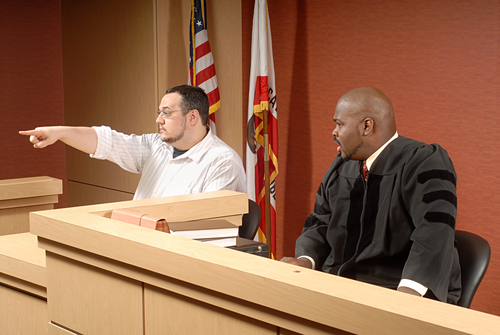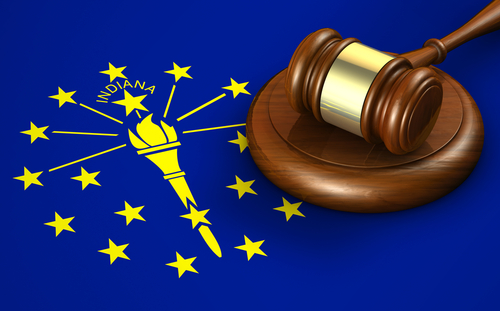When a witness confronts the accused: Is a courtroom ID fair?

Shutterstock
It’s one of the oldest courtroom gambits in America: a prosecutor in a criminal trial asks a key witness if he sees the person who committed the crime anywhere in the room. Pause. The witness turns and points to the defendant, as the jurors take it all in.
But this enduring practice, dating back to colonial courthouses, has come under fire in the last few years as an often unreliable tool that has no place in a 21st century trial.
Citing a vast body of research on the fallibility of eyewitness testimony in general, questions are now being raised specifically about in-court identification. Some experts say the tactic is unduly suggestive, ineffectively tests a witness’s memory, and provides more theatrical flourish than probative evidence. They also say that the process leaves room for error.
Massachusetts and Connecticut have already limited the use of this approach. In both states, the main concern was that the witness in the courtroom was making the identification for the first time, and had not previously picked the defendant out of a standard lineup or photo array. In some cases, the witness may be making the courtroom identification weeks—or even years—after the crime took place.
A 2016 state supreme court decision in Connecticut held that witnesses cannot be asked for an in-court identification unless they knew the defendant before witnessing the crime or have already successfully identified the defendant in an out-of-court procedure, or the perpetrator’s identity is not contested.
In Massachusetts in 2014, the state’s top court largely banned the practice for cases in which witnesses had been anything short of unequivocal in identifying the defendant before the trial. It’s possible that Colorado will soon be joining them.
The push to restrict in-court identification began roughly five years ago with efforts by The Innocence Project, a nonprofit legal organization that seeks to exonerate the wrongly convicted. The group, which hopes to continue its efforts around the country, has kept data on DNA exonerations in the U.S. since 1989. It reported that 71 percent of those wrongful convictions have involved some kind of mistaken eyewitness identification, both in and out of court. Of that 71 percent, more than half involved an incorrect in-court identification.
Innocence Project lawyers contend that first-time in-court identification increases the risk of wrongful conviction. They argue that the powerful theatrics of pointing to the defendant can sometimes overcome the shortcomings of a weak case.
“You really start to wonder why we are doing this,” said Karen Newirth, a senior staff attorney at The Innocence Project. “It’s injecting a whole lot of prejudice because jurors find it incredibly powerful.”
The courtroom layout—with the accused seated next to defense counsel—leaves little doubt about who the state is trying to prosecute, Newirth said. The defendant may be the only person in the room who matches the witness’s description. Instead of relying on what he remembers from the crime scene, a witness might guess or simply point to the defendant because he seems like the most obvious choice in the courtroom setting.
In Colorado, Newirth filed a brief in the case of James Joseph Garner, who was accused of shooting and injuring several people at a bar in 2009. According to Rachel Milos, Garner’s lawyer, no witnesses could pick Garner out of a photo array just four months after the alleged crime.
But when two witnesses took the stand more than two years later, they positively identified him as the perpetrator. He was convicted of attempted reckless manslaughter, first-degree assault, and second-degree assault soon after. Garner appealed his conviction, but the appellate court upheld it. His case is currently pending before the Colorado Supreme Court.
When writing the Garner brief, Newirth looked to the case in Connecticut that changed the practice there. Similarly, a witness failed to identify the defendant, Andrew Dickson, who is black, as his assailant in a photo array a year after the crime. When asked who committed the crime in court almost three years after the incident, the witness pointed to Dickson—the only African-American man in the room, besides a uniformed court officer.
“Of course they’re not going to pick a spectator, they’re not going to pick the bailiff, they’re going to pick the person at the table being prosecuted,” said Princess Dickson, Andrew’s mother. “Once you’re sitting in that courtroom, as a victim, you don’t want to think the police got it wrong.”
In the Dickson case, the Connecticut court tightened its approach to the longtime practice. Now, witnesses cannot identify defendants in court unless they knew the defendant before witnessing the crime or they have successfully picked the defendant from a non-suggestive photo array or lineup before the trial.
The new guidelines, however, did not retroactively apply to Dickson, because the court ruled that the jury would have found him guilty anyway. He appealed his conviction and was denied.
Laurie Feldman, an appellate prosecutor who represented the state of Connecticut in Dickson’s case, emphasized that all kinds of evidence—not just in-court identifications—come with the possibility of error. Cross-examination and jury instructions, she said, are meant to act as “safeguards”—the reliability of evidence is for the jurors to decide.
“The U.S. Supreme Court has made clear that identification evidence in particular should not be suppressed from trial simply because it might be erroneous,” Feldman said.
Connecticut judges ruled that the in-court identification violated Dickson’s constitutional rights to fair legal process because the identification was unnecessarily suggestive. Feldman called the constitutional arguments “anachronistic,” highlighting the fact that in-court identification has been a feature of criminal trials for centuries—even before pre-trial procedures or police forces existed.
The historic nature of the practice is hardly a point of contention. In the Dickson opinion, Connecticut judges cited John Langbein, a legal historian at Yale who described the centrality of eyewitness identification in early English and American justice systems. The procedure became tradition when litigants might have traveled on horseback: long before the advent of DNA testing, fingerprint technology, or the large body of research on the limitations of memory.
“Tradition is a powerful argument for some and that’s hard to change,” Newirth said. “We’re asking courts to change decades of precedence, and that’s a very hard thing to do.”
This article was originally published by The Marshall Project, a nonprofit news organization covering the U.S. criminal justice system. Sign up for their newsletter, or follow The Marshall Project on Facebook or Twitter.



